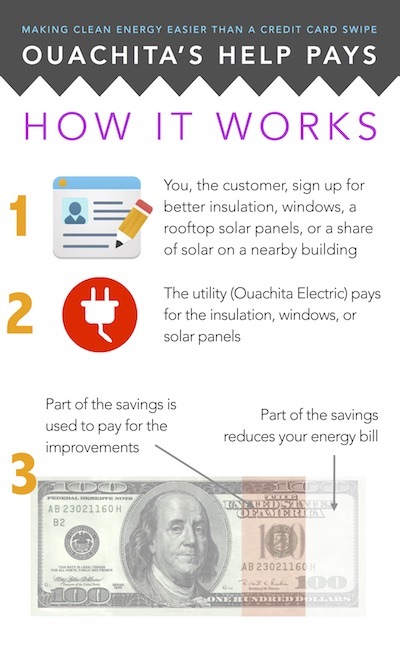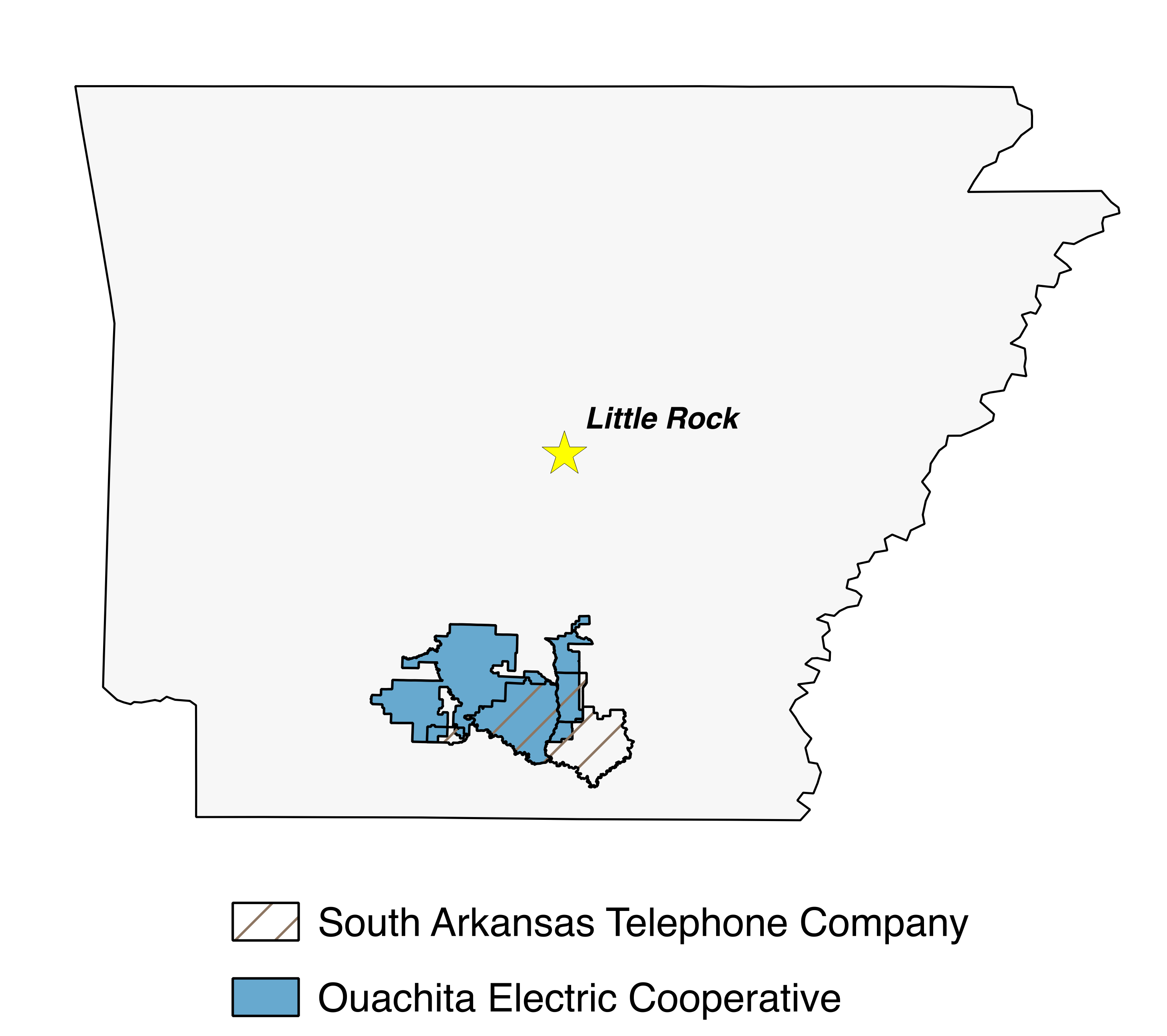Arkansas Utility Leads On Energy & Broadband
Originally published at ilsr.org.
This article was co-written with ILSR’s Community Broadband Networks initiative research associate, Hannah Trostle, and this piece is cross-posted on MuniNetworks.org.
Ouachita Electric Cooperative, nestled deep in south-central Arkansas, is an unlikely innovator in a pair of industries struggling to adapt to shifting market dynamics: electricity and broadband.
Despite rising demand for energy efficiency and renewable electricity generation, large investor-owned utilities — and many rural electric co-ops — have resisted programs to address those needs. Likewise, corporate Internet service providers frequently offer shoddy service at high rates, a particular problem in rural areas with limited competition.
But Ouachita Electric found a way to do both things better, with complementary technologies. Fiber-optic network investments provided lower cost Internet access, but also provide an information backbone for the electric utility that can reduce outage times and verification for energy savings programs. The network and the efficiency programs reduce costs for a customer base dominated by low-income households that can now reinvest their earnings elsewhere in the community.
 Inclusive Financing
Inclusive Financing
The utility’s tariff-based, on-bill financing program — known as HELP PAYS — allows customers to invest in energy efficiency upgrades at their homes, like insulation and heat pumps, at no upfront cost. Ouachita Electric covers eligible expenses, then recoups its buy-in through payments from participating customers on their monthly bills. Customers immediately pay less thanks to utility-financed energy-saving improvements.
Unlike other energy efficiency programs, the opt-in “inclusive financing” program, HELP PAYS, enables all Ouachita customers to capture significant benefits:
- Low-income households can pay, because they don’t need to come up with thousands of dollars upfront for qualifying improvements.
- Renters can participate, because monthly charges are attached to individual meters rather than individual customers, meaning they won’t be saddled with costs if they move.
- The tariff structure does not hinge eligibility on a minimum credit score, unlike loan-based programs that rely on private financiers.
Customer interest in the tariff-based, on-bill program surged immediately after Ouachita Electric implemented it last year. In the first three months, the number of customers seeking efficiency assessments — a precursor to improvements — doubled, from 73 to more than 162.
In August, the utility reported 100% of multifamily and rental units eligible for the program had opted in. At the same point, 92% of single-family customers that had received offers to invest in upgrades agreed to do so.
The impact of inclusive financing is especially pronounced in this co-op’s service territory, where the average household income hovers around $33,000 per year, far below the national median of $52,000.
But the benefits of inclusive financing, as proven by Ouachita Electric, extend much further.
The enterprising utility reports cost savings, confirmed and quantified using smart meters. Thanks to inclusive financing, Ouachita Electric has reduced the amount it spends on power to supply electricity to its members. Going forward, it will curb the need to add expensive new generation capacity.
A New Fiber Network
Electric cooperatives have tried a number of approaches to improve internet access for their largely rural customers, from working with satellite communication companies to experimenting with broadband over power lines. Now, Ouachita Electric has started a project to bring some of the fastest Internet service in the U.S. to their co-op members.
 Ouachita Electric is collaborating with the local, family-owned, telephone company, South Arkansas Telephone, which already provides Internet service to half of Ouachita Electric’s service territory. The partnership, the Arkansas Rural Internet Service (ARIS), is set to bring phone, video, and gigabit Internet service — more than ten times the speeds typically offered by cable companies — to all 9,500 homes and businesses throughout Ouachita Electric’s service territory.
Ouachita Electric is collaborating with the local, family-owned, telephone company, South Arkansas Telephone, which already provides Internet service to half of Ouachita Electric’s service territory. The partnership, the Arkansas Rural Internet Service (ARIS), is set to bring phone, video, and gigabit Internet service — more than ten times the speeds typically offered by cable companies — to all 9,500 homes and businesses throughout Ouachita Electric’s service territory.
Ouachita Electric and South Arkansas Telephone are co-owners of ARIS, as described by ARIS Director Mark Lundy in Telecompetitor. As such, they will share both the cost of construction and the overall revenues.
Mark Cayce, the general manger of Ouachita Electric Cooperative, explained that the partnership builds on the strengths of both the electric cooperative and the local telephone company:
“They have technical expertise and back office skills we didn’t have. We have access to our members and we built a long-standing reputation of a company that provides really good service.”
They announced the project in mid-June 2016, expecting to hook up the first customers that September. ARIS will offer speeds of up to one gigabit (1,000 Mbps) directly to homes for less than $100 per month. The entire venture will involve installing about 1,800 miles of fiber over the next few years.
These rural communities cannot wait for the better connectivity — which won’t just be better than what they had, it will rival the best networks in the country. Within the first week of the announcement, over 400 members signed up for service.
Fiber networks not only provide high-speed Internet service, but also create opportunities to innovate. Cities have used fiber to improve traffic management, electrical systems, and public safety systems. Ouachita Electric’s investment could enable many of these innovations, but they are starting with smart meters.
Complementary Benefits
With real-time sensors, these smart meters monitor power quality and can deliver notifications of power outages. They form part of a smart grid system that improves monitoring and management of the overall electric power system, resulting in power savings and lower costs.
In an April 2012 report, ILSR explained the benefits of the smart grid owned by Chattanooga municipal utility EPB in reducing the time customers are without power:
“EPB credits the smart grid automation with preventing 2.4 million customer minutes of interrupted service during the 2011 tornadoes alone. As of Feb 29, EPB reported that its fiber network had saved 5 million customer minutes interrupted since July 1, 2011 — an average of 30 minutes per customer.“
Chattanooga’s smart grid again proved its worth during the July 2012 storms that caused regional power outages. EPB and Oak Ridge National Laboratory’s case study found that the smart grid reduced customer outage time by 55% and customer costs by 33%. In that one day alone, the smart grid saved the city utility more than $1 million in the expected overtime costs for restoring service.
A 2017 publication by the Berkman Klein Center for Internet & Society at Harvard University estimated that the EPB smart grid also provides indirect benefits of $43.5 million annually. That number only includes cost savings from quickly detecting failing equipment and isolating potential problems. EPB also directly saves at least $9.6 million with the new sensors — from catching power theft to better regulating power purchasing.
Additionally, the Chattanooga EPB smart grid actually prevented a house fire, in 2014. Thanks to the real-time information from the smart meter, the municipal electric utility sent a nearby employee to check out an anomaly. It turned out to be a fire in the bushes near the back door of a home. The employee put out the fire and fixed the electric line all before the family came home from church. This would not have been possible without the community fiber network supporting high-speed communication between the meter and the utility.
Ouachita Electric’s decision to invest in the fiber network means the co-op’s members will be well-connected and well-served. Members will save money and conserve energy with the smart meters, and they will have access to some of the most reliable, highest-speed Internet service in the entire country.
What’s Next
Ouachita Electric has cemented its status as a pioneer in boosting access to energy programs and broadband, but it shouldn’t be an outlier. The co-op’s attentiveness to its member-owners’ needs spotlights opportunities to introduce well-designed initiatives that plug gaps in the local economy. It’s a formula that should attract all co-ops, designed with democratic ideals in mind.
These initiatives are a set of powerful tools to address low member-owner engagement that plagues rural utilities nationwide. With trailblazers like Ouachita modeling real-world initiatives that deliver measurable results, other co-ops and their member-owners face a substantially lower barrier to pitching and implementing similar efforts, and to cash in on the robust — and proven — potential of energy savings and Internet access.
For timely updates, follow Karlee Weinmann on Twitter or get the Energy Democracy weekly or Community Broadband Networks weekly update.
Photo Credit: Justin Cozart via Flickr (CC BY-SA 2.0)
Have a tip for CleanTechnica? Want to advertise? Want to suggest a guest for our CleanTech Talk podcast? Contact us here.
Latest CleanTechnica.TV Video

CleanTechnica uses affiliate links. See our policy here.
